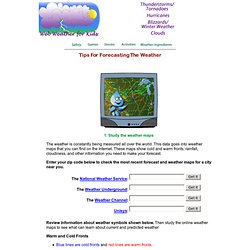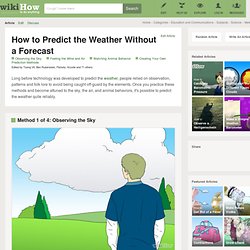

Tips For Forecasting The Weather. 1.

Study the weather maps The weather is constantly being measured all over the world. This data goes into weather maps that you can find on the Internet. These maps show cold and warm fronts, rainfall, cloudiness, and other information you need to make your forecast. Enter your zip code below to check the most recent forecast and weather maps for a city near you. Review information about weather symbols shown below. Warm and Cold Fronts Each circle represents a weather station. Wind and Wind Direction The little arrows attached to each weather station point in the direction the wind is blowing from.
Air Temperature The number to the upper left of each station is the air temperature in degrees F (for U.S. maps) or degrees C (for other countries). Dew Point The number to the lower left of each station is the dew point temperature in degrees F (for U.S. maps) or degrees C (for other countries). Barometric Pressure The number to the upper right of each station is the barometric pressure. 2. How to Predict the Weather Without a Forecast. Steps Method 1 of 4: Observing the Sky 1Examine the clouds.

The types of clouds in the sky, as well as the direction in which they're moving, can tell you a lot about upcoming weather. In general, clouds that are white and high indicate good weather, and clouds that are dark and low mean rain or storms are on the way. [1]The presence of cumulonimbus clouds early in the day, with more developing throughout the day can mean there's a greater chance of severe weather occurring soon.Mammatus clouds (formed by sinking air) can form with both severe and non-severe thunderstorms.Cirrus clouds, or "mare's tails," high in the sky like long streamers, mean bad weather is coming within the next 36 hours.Altocumulus clouds, which are like mackerel scales, also point to bad weather coming within the next 36 hours.Mackerel skies and mares tails formations sometimes appear in the same sky. 4Gaze at the moon.
Method 2 of 4: Feeling the Wind and Air. Predicting Weather. United States Search and Rescue Task Force Predicting Weather What Is Weather?

Weather simply refers to the condition of the air on earth at a given place and time - whether it is warm or cold, dry or wet, blowing or calm. The condition of air and how it acts to create weather is influenced primarily by two things - heat (the sun) and water. Weather on earth starts with the sun. Water evaporates into the air air rises As air rises, its temperature drops. Fronts and Air Masses Weather maps show the positions of air masses. When one air mass meets another, the air in different masses usually does not mix because the properties of the air are different.
Cold Front A cold front forms where a cold air mass moves into a warm air mass. Warm Front A warm front forms where a warm air mass moves into a cold air mass. Stationary Front Even though air masses often move, sometimes they don't, resulting in a stationary front. High and Low Air Pressure.